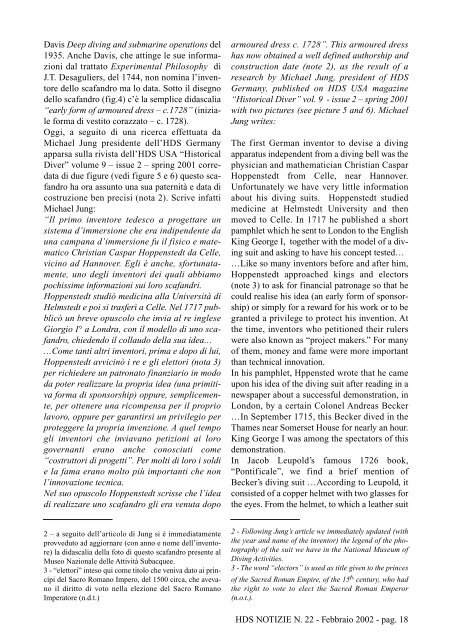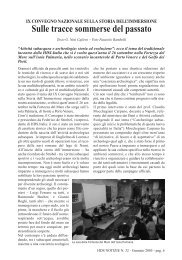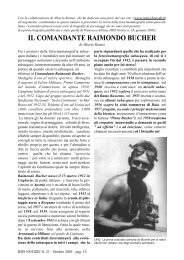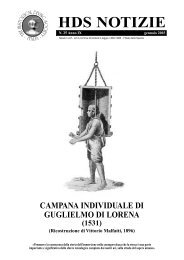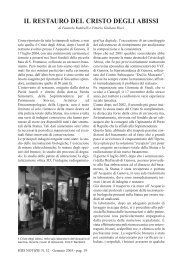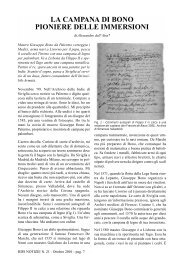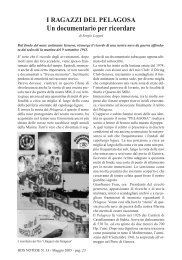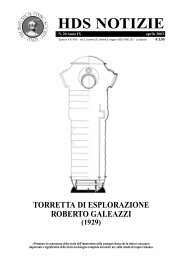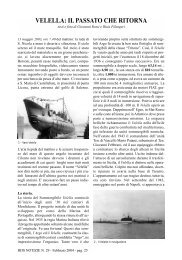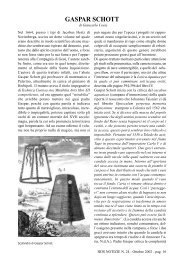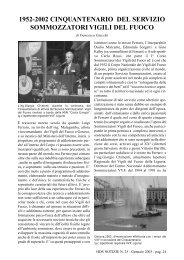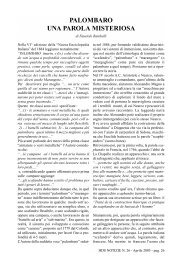hds internet - The Historical Diving Society Italia
hds internet - The Historical Diving Society Italia
hds internet - The Historical Diving Society Italia
Create successful ePaper yourself
Turn your PDF publications into a flip-book with our unique Google optimized e-Paper software.
Davis Deep diving and submarine operations del<br />
1935. Anche Davis, che attinge le sue informazioni<br />
dal trattato Experimental Philosophy di<br />
J.T. Desaguliers, del 1744, non nomina l’inventore<br />
dello scafandro ma lo data. Sotto il disegno<br />
dello scafandro (fig.4) c’è la semplice didascalia<br />
“early form of armoured dress – c.1728” (iniziale<br />
forma di vestito corazzato – c. 1728).<br />
Oggi, a seguito di una ricerca effettuata da<br />
Michael Jung presidente dell’HDS Germany<br />
apparsa sulla rivista dell’HDS USA “<strong>Historical</strong><br />
Diver” volume 9 – issue 2 – spring 2001 corredata<br />
di due figure (vedi figure 5 e 6) questo scafandro<br />
ha ora assunto una sua paternità e data di<br />
costruzione ben precisi (nota 2). Scrive infatti<br />
Michael Jung:<br />
“Il primo inventore tedesco a progettare un<br />
sistema d’immersione che era indipendente da<br />
una campana d’immersione fu il fisico e matematico<br />
Christian Caspar Hoppenstedt da Celle,<br />
vicino ad Hannover. Egli è anche, sfortunatamente,<br />
uno degli inventori dei quali abbiamo<br />
pochissime informazioni sui loro scafandri.<br />
Hoppenstedt studiò medicina alla Università di<br />
Helmstedt e poi si trasferì a Celle. Nel 1717 pubblicò<br />
un breve opuscolo che invia al re inglese<br />
Giorgio I° a Londra, con il modello di uno scafandro,<br />
chiedendo il collaudo della sua idea…<br />
…Come tanti altri inventori, prima e dopo di lui,<br />
Hoppenstedt avvicinò i re e gli elettori (nota 3)<br />
per richiedere un patronato finanziario in modo<br />
da poter realizzare la propria idea (una primitiva<br />
forma di sponsorship) oppure, semplicemente,<br />
per ottenere una ricompensa per il proprio<br />
lavoro, oppure per garantirsi un privilegio per<br />
proteggere la propria invenzione. A quel tempo<br />
gli inventori che inviavano petizioni ai loro<br />
governanti erano anche conosciuti come<br />
“costruttori di progetti”. Per molti di loro i soldi<br />
e la fama erano molto più importanti che non<br />
l’innovazione tecnica.<br />
Nel suo opuscolo Hoppenstedt scrisse che l’idea<br />
di realizzare uno scafandro gli era venuta dopo<br />
armoured dress c. 1728”. This armoured dress<br />
has now obtained a well defined authorship and<br />
construction date (note 2), as the result of a<br />
research by Michael Jung, president of HDS<br />
Germany, published on HDS USA magazine<br />
“<strong>Historical</strong> Diver” vol. 9 - issue 2 – spring 2001<br />
with two pictures (see picture 5 and 6). Michael<br />
Jung writes:<br />
<strong>The</strong> first German inventor to devise a diving<br />
apparatus independent from a diving bell was the<br />
physician and mathematician Christian Caspar<br />
Hoppenstedt from Celle, near Hannover.<br />
Unfortunately we have very little information<br />
about his diving suits. Hoppenstedt studied<br />
medicine at Helmstedt University and then<br />
moved to Celle. In 1717 he published a short<br />
pamphlet which he sent to London to the English<br />
King George I, together with the model of a diving<br />
suit and asking to have his concept tested…<br />
…Like so many inventors before and after him,<br />
Hoppenstedt approached kings and electors<br />
(note 3) to ask for financial patronage so that he<br />
could realise his idea (an early form of sponsorship)<br />
or simply for a reward for his work or to be<br />
granted a privilege to protect his invention. At<br />
the time, inventors who petitioned their rulers<br />
were also known as “project makers.” For many<br />
of them, money and fame were more important<br />
than technical innovation.<br />
In his pamphlet, Hppensted wrote that he came<br />
upon his idea of the diving suit after reading in a<br />
newspaper about a successful demonstration, in<br />
London, by a certain Colonel Andreas Becker<br />
…In September 1715, this Becker dived in the<br />
Thames near Somerset House for nearly an hour.<br />
King George I was among the spectators of this<br />
demonstration.<br />
In Jacob Leupold’s famous 1726 book,<br />
“Pontificale”, we find a brief mention of<br />
Becker’s diving suit …According to Leupold, it<br />
consisted of a copper helmet with two glasses for<br />
the eyes. From the helmet, to which a leather suit<br />
2 – a seguito dell’articolo di Jung si è immediatamente<br />
provveduto ad aggiornare (con anno e nome dell’inventore)<br />
la didascalia della foto di questo scafandro presente al<br />
Museo Nazionale delle Attività Subacquee.<br />
3 - “elettori” inteso qui come titolo che veniva dato ai principi<br />
del Sacro Romano Impero, del 1500 circa, che avevano<br />
il diritto di voto nella elezione del Sacro Romano<br />
Imperatore (n.d.t.)<br />
2 - Following Jung’s article we immediately updated (with<br />
the year and name of the inventor) the legend of the photography<br />
of the suit we have in the National Museum of<br />
<strong>Diving</strong> Activities.<br />
3 - <strong>The</strong> word “electors” is used as title given to the princes<br />
of the Sacred Roman Empire, of the 15 th century, who had<br />
the right to vote to elect the Sacred Roman Emperor<br />
(n.o.t.).<br />
HDS NOTIZIE N. 22 - Febbraio 2002 - pag. 18


